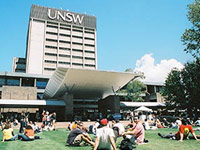|
|||||||||||||||||||||||||||||||||||||||||||||||
| Environmental Engineering/Arts - 3626 | |||||||||||||||||||||||||||||||||||||||||||||||

With this combined degree program, students can add their choice of an Arts program to the standard, professionally accredited Environmental Engineering program offered by the School of Civil and Environmental Engineering. It provides flexibility in the choice of courses within the full Arts program and enables students to gain a broad education in Arts and Social Sciences, as well as specialised studies in Environmental Engineering.
Because Engineering and Arts programs can have a common content, such as mathematics and physics, two additional sessions of study is required to gain the additional qualification of Bachelor of Arts. In general, this additional study is taken concurrently with the BE program and both can be completed in ten sessions. Eligibility The program is open to all students who satisfy both the Environmental Engineering and Arts entry conditions. Students may enter directly in Year 1 or may apply to transfer from the normal engineering program after completion of at least one year if they have a credit or higher average. Transfer after the second year may result in students taking more than minimum time to complete the combined program. Organisation The BE BA program is administered by the School of Civil and Environmental Engineering. The School will consult with the Faculty of Arts and Social Sciences in approving the BA component of the program. The final program and timetable must be approved by the School of Civil and Environmental Engineering. Students should start discussing their program with representatives of the School and the Faculty of Arts and Social Sciences as early as possible. Students should themselves determine the Arts program that they wish to undertake. The Arts and Social Sciences section in this Handbook describes the options. There are no special rules on what courses should be included in each year. Students should schedule the Arts and Engineering components to suit their preferences, while meeting the constraints of timetables and prerequisites. Students will need to refer to the Faculty of Arts and Social Sciences section in this Handbook. Program Objectives and Learning Outcomes Please see http://www.eng.unsw.edu.au/rules/
Please refer to the Academic Rules below and contact the School of Civil and Environmental Engineering for information on the Program Structure of this degree.
1. In addition to the BE program, students must complete 60 units of credit in the BA program, with no more than 24 units of credit obtained at Level 1 (ie courses designed for students in their first year of study). Of these 24 Level 1 units of credit, no more than 12 units of credit may be from any one sequence of study.
2. Students must complete a major sequence (42 units of credit) in one of the following areas :
*Students completing an Environmental Studies major sequence must complete, in addition to the 30 Upper Level units of credit specified, 6 Level 1 units of credit in an approved course. Students must also complete a minor sequence of 24 units of credit in one of the other areas listed above.
3. Except for courses completed as part of the major sequence, no more than 12 units of credit may be obtained from courses in the BA program which are offered by Schools outside the Faculty of Arts and Social Sciences. 4. No course included for credit in the BE program can be included in the 60 units of credit required at Rule 1 for the BA program. 5. Students must complete the full requirements of Program 3625 BE in Enviornmental Engineering except that they are exempt from the General Education requirements of the BE program. However, students will not be eligible for graduation for the BE until a minimum of 12 units of credit of the BA program have been successfully completed. 6. Students who complete the requirements for the BA program and the first two years of the BE BA program may proceed to graduation with the degree of Bachelor of Arts. 7. Students may be awarded Honours in the BA by successful completion of honours year. It should be noted that entry into a particular BA Honours program might require completion of courses additional to those specified under Rules 1-4. 8. The total units of credit in the program is 5 x 48 = 240 For academic rules relating to the Bachelor of Engineering component of this combined program, please refer to http://www.eng.unsw.edu.au/rules/ For information regarding fees for UNSW programs, please refer to the following website: https://my.unsw.edu.au/student/fees/FeesMainPage.html
Please see http://www.eng.unsw.edu.au/rules/
Please see http://www.eng.unsw.edu.au/rules/
Area(s) of Specialisation |
|||||||||||||||||||||||||||||||||||||||||||||||


